Vegetable main courses using the best of British bounty
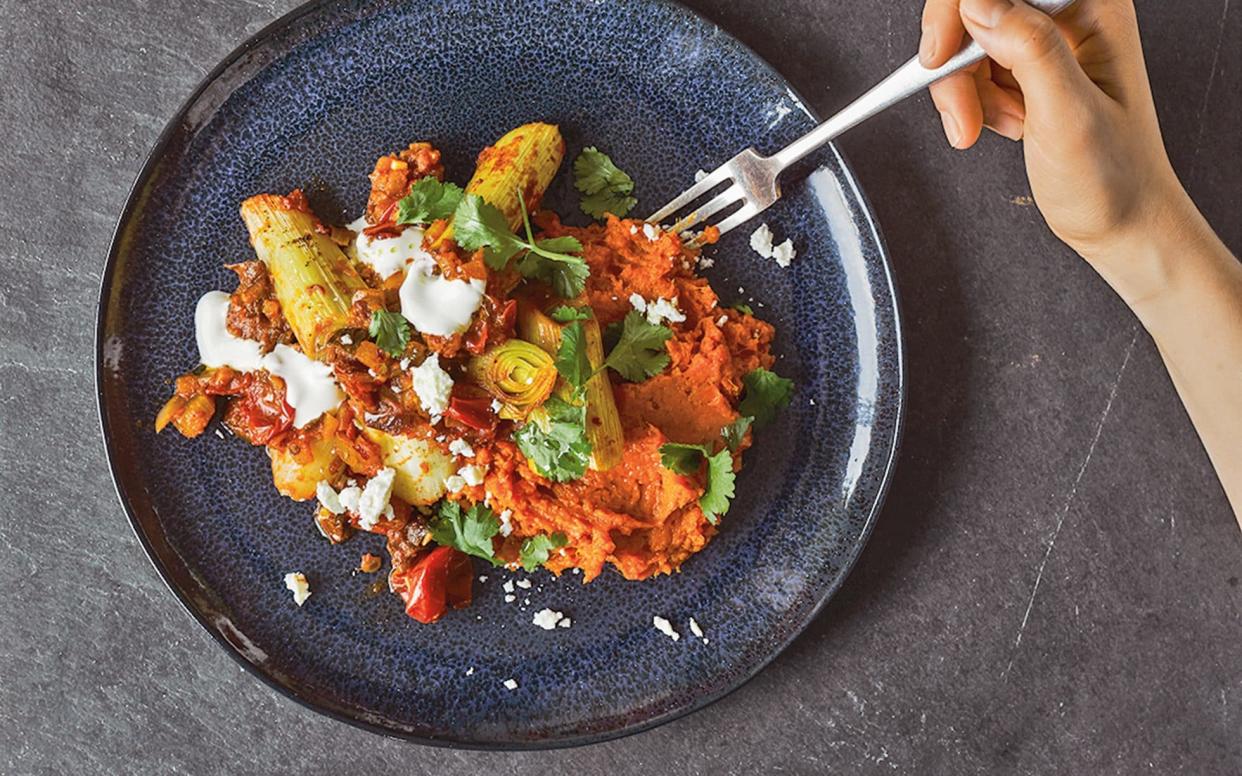
I’ve been re-reading American chef Gabrielle Hamilton’s brilliant memoir, Blood, Bones & Butter, and laughing at how she punches the food world’s dearest shibboleths. Shopping for vegetables, she notes that whoever came up with the ‘local and seasonal’ mantra must live in California.
What’s surprising is that Hamilton experiences this exasperation in a summer market in Puglia. ‘My jaw tightens and I’m grinding my molars at all this eggplant [aubergine],’ she writes. ‘Twenty-one days of local eggplant season is torture.’ She has simply run out of ideas.
Ironically, in this country, aubergines are one of the ingredients we most often reach for. Their velvety flesh is ‘meaty’ and can suck up all manner of flavours; peppers are loved too because of their sweet flesh. Both char well and take on a luscious smokiness.
But we’re not barbecuing in February. M&S has been on the naughty step for daring to put a slice of cauliflower in a plastic bag and calling it a steak, but at least it’s grown here and it’s in season.
Mediterranean countries have an enviable repertoire of vegetable dishes. The Italians, in particular, give them pride of place (in the same book Hamilton eats Puglian beans that are ‘pure chlorophyll’), but my heart sinks when I look at suggestions for winter meals and see aubergine bakes and gratins of roasted peppers.
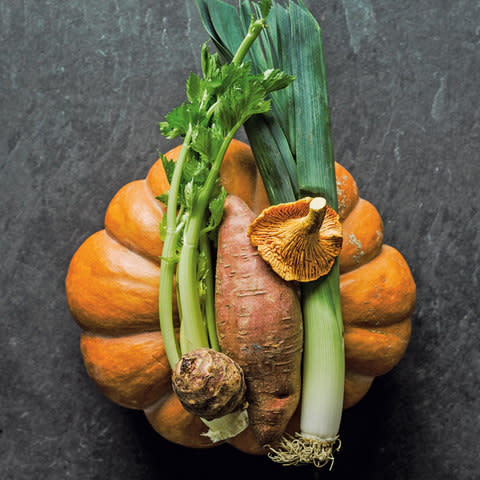
They’re lovely dishes, but it’s not the season for these vegetables and we don’t grow them. Meanwhile, we pout at our root veg and snigger at our swedes. We have beetroot, carrots, cauliflower, leeks, broccoli, Jerusalem artichokes, cabbages, mushrooms and celeriac – what colour, flavour or texture is missing here?
They may be more likely to make you think of foggy mornings than sun-kissed afternoons, but they’re wonderful vegetables.
When I was in Russia recently, home cooks told me they couldn’t survive financially without the vegetables they grow, the beetroot and cabbages that are the backbone of their soups, stews and pies. There, I sat down to baked potatoes with smoked butter, sour cream and pickled mushrooms; buckwheat with pumpkin and hazelnuts; beetroot mousse with dill and salty cheese. I didn’t wish that I was in the Med.
Get cooking | Diana Henry’s latest recipes
Here, we’ve applied limited techniques to vegetables. We’ve done a lot of boiling when we can also braise, bake, deep-fry, sweat in butter and roast. Our first response to embracing vegetables has been to have an affair with the Mediterranean.
What we should be doing is looking at how these countries honour their vegetables – not, in the depths of winter, cooking an Italian summer. Aubergines can wait.
Pumpkin and chestnut plov with yogurt and spiced butter
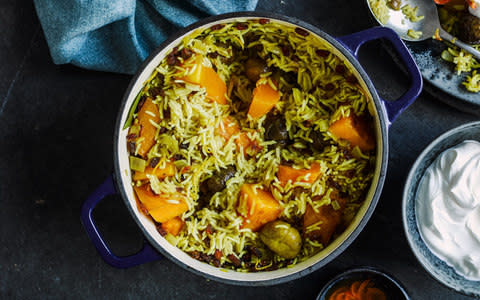
I’ve always associated pumpkin and squash with the US and Italy, but we grow them here – and in abundance. I had plov, a rice dish cooked in stock, in Russia (without the yogurt and butter). If you want to add herbs, fork through chopped coriander, parsley or dill (or a mixture) before serving.
SERVES
4
INGREDIENTS
1½ tbsp olive oil (or whatever oil you prefer)
400g pumpkin, cut into chunks (prepared weight)
1 onion, finely chopped
½ tsp turmeric
225g basmati rice
2 bay leaves
½ cinnamon stick
45g dried cranberries or dried barberries
100-125g cooked chestnuts, halved
finely grated zest of 1 orange
750ml vegetable stock
To finish
40g butter
2 red chillies, halved, deseeded and cut into slivers (you can use dried chilli flakes if you don’t have any fresh ones)
8 large spoonfuls of Greek yogurt
METHOD
Heat the oil in a large saucepan and cook the pumpkin until it is golden – even caramelised in places – then remove the pieces with a slotted spoon and set aside.
Add the onion to the pan and cook until soft and pale gold. Add the turmeric and cook for another minute.
Tip in the rice and stir it round in the fat and onion for a couple of minutes. Put the pumpkin back into the pan along with the bay leaves, cinnamon, dried fruit, chestnuts and orange zest. Pour in the stock and season well. Bring to the boil and boil hard for two minutes, leaving the pan uncovered. There should be just a little liquid still on top of the rice.
Wrap the lid in a tea towel and put it on the pan, making sure that none of the cloth is hanging over that could catch on the flame. Turn the heat down low and leave to cook for 15 minutes. The rice should be perfectly cooked. Fork it through. Check the seasoning.
Heat the butter in a saucepan or frying pan and quickly sauté the chillies (they just need a minute). Serve the plov topped with yogurt, and pour spiced butter over each portion.
Jerusalem-artichoke fritters with wild mushrooms and fried egg
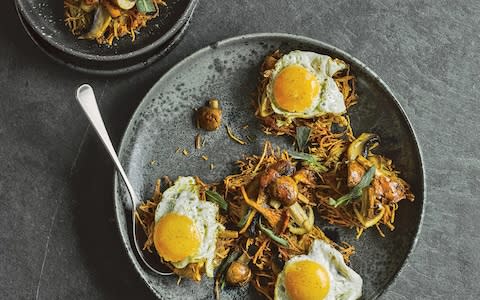
SERVES
4
INGREDIENTS
For the fritters
250g potatoes, peeled
370g Jerusalem artichokes, well scrubbed
3 medium eggs
4 tbsp plain flour
½ tsp ground cayenne
oil for frying
For the mushrooms and eggs
400g wild or cultivated mushrooms, or a mixture
1 tbsp olive oil, plus more for frying the eggs
2 cloves garlic, finely chopped
15g unsalted butter
¼ tbsp chopped parsley or sage
4 large eggs
METHOD
Grate the potatoes on the coarse side of a box grater. Transfer to a sieve and wash to remove some of the starch. Put into a clean tea towel and squeeze the potato to remove the excess water. Grate the artichokes as well. Mix them in a bowl with the potatoes and all the other fritter ingredients (except the oil) and some seasoning.
Slice or halve the mushrooms, depending on what kind you are using.
Heat the oil for frying the fritters in a large frying pan. Put a heaped spoonful of the mixture in the pan and pat it down until it measures about 8cm across. You should be able to cook four at a time. Cook these over a medium heat for about four minutes on each side (turn them a couple of times) until the outside is golden and the vegetables are soft and cooked. Transfer to a low oven to keep warm.
Quickly heat the oil for the mushrooms in a large pan and sauté them briskly. Mushrooms give out a lot of moisture – you need to cook it off so it evaporates. Add the garlic and sauté for another minute, then season and add the butter and parsley or sage. It’s best to fry the eggs in another pan at the same time as the mushrooms.
Serve two fritters per person. Put the mushrooms on top, together with their buttery juices, and top each serving with an egg.
Sweet-potato mash with chipotle roasted leeks
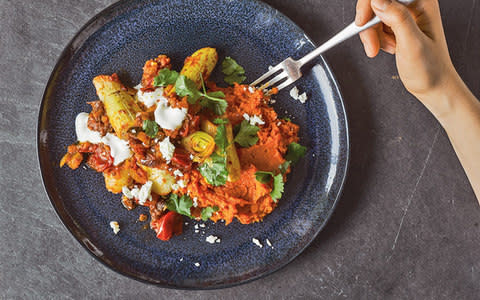
If you can’t find chipotle chillis you can use chipotle paste instead (it comes in jars - you’ll need 2 tbsp) and omit the brown sugar. You do need a pan 30cm across so you can fit in the leeks in a single layer and ensure the tomato sauce reduces properly in the time.
SERVES
4
INGREDIENTS
3 chipotle chillies
8 fat leeks
1½ tbsp olive oil, plus a little more for drizzling
1 onion, finely chopped
1 stick celery, diced
2 tsp ground cumin
2 cloves garlic
1 x 400g tin cherry tomatoes in thick juice
2 tsp soft dark-brown sugar
2 bay leaves
1 cinnamon stick
½ tsp dried chilli flakes
For the mash
4 large sweet potatoes
To serve
chopped coriander
sour cream
crumbled goat’s cheese
METHOD
Pour just enough boiling water over the chipotle chillies to cover them, and leave to soak for an hour. Preheat the oven to 190C/180C fan*/gas mark 5.
Trim the leeks at the top and bottom and remove the tougher outer layers. Cut each one into 8-10cm lengths.
Heat the olive oil in a 30cm heavy-based shallow casserole or sauté pan. Add the onion and celery and fry, stirring frequently, until soft and pale gold. Add the cumin and garlic and cook for another couple of minutes, then add the tomatoes, sugar, bay leaves, cinnamon and chilli flakes. Drain the chipotles. Remove the stems, chop the chillies finely and add them to the tomato mixture with 100ml water (or vegetable stock).
Put the leeks into the pan with the tomatoes, season and drizzle with a little oil. Bake, uncovered, for 30-40 minutes. Put the sweet potatoes on to a metal baking sheet and bake, at the same time, for 30-45 minutes. They should be tender.
The sauce should have reduced so that it’s quite thick and the leeks should be tender through to the middle. (Turn the leeks over halfway through the cooking time.) If the sauce is too liquid, cook it over a high heat on the hob until it has reduced enough. If it’s too thick and intense, add a little water and heat through.
Halve the sweet potatoes and scoop out the flesh, discarding the skins. Mash roughly with some seasoning – it should still have some texture – and season. Serve the leeks with the mash. Scatter the coriander on top and offer the cream and cheese on the side.
*Diana’s conversion may differ slightly from the standard

